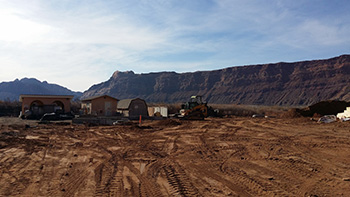 Utah and Bruce Babbitt have a history.
Utah and Bruce Babbitt have a history.
In the 1990s, when he led efforts to designate nearly two million acres of the Grand Staircase Escalante area as a National Monument, folks here hung him in effigy.
How foul was THAT vibe?
But earlier this winter, Babbitt was among friends. He received a standing ovation before AND after his talk in Salt Lake City. He lambasted Governor Herbert as well as Utah’s land-grabbing legislative efforts, better known as H.B. 148 “Transfer of Public Lands Act and Related Study.”
“The real reason for this [transfer legislation] is to provide a conduit by which the public lands of this state can be transferred to Utah in order to be served up to coal, oil and gas, and mineral industries for exploitation,” he said. In addition, he spoke scathingly of the 784-page study of the proposed land transfer, conducted by the University of Utah, Weber State University, and Utah State University.
The land grab would have a particularly drastic effect in and around Moab, where so much of the land is public. Babbitt continued, “This movement right now is kind of being dressed up with a bunch of universities and academics making metrics and economic arguments.” The report, in fact, does address the impact on outdoor recreational interests with the exact statistics used by Babbitt: it’s a $645 billion annual industry, growing five percent annually. It’s bigger than pharmaceuticals, motor vehicles, and gas industries,it said.
John Dowden is a senior analyst at the University of Utah Bureau of Economic and Business Research and one of the lead authors of the two-year study. He said “we expected that not everyone would be happy. [Industry proponents] thought it was going to be a slam dunk, a vast improvement over the current situation. Our results didn’t show that either. It’s easy to cherry pick, but it’s complex and there are a lot of moving parts. The notion that the state would allow oil and gas drilling all over or that Utah would sell off the land is inaccurate,” said Dowden. He called outdoor recreation and tourism “important facets” included in the study and in the legislation. It’s true, though, the bulk of the report is dedicated to expected mineral leases, mining sales, timber, gas and coal development and the gains therein.
Babbitt, 76, compared the recent land transfer movement to the Sagebrush Rebellion of the 1970-80s, in which several western states’ citizens and politicians lobbied (sometimes violently) for states’ claim on federal land. The federal government owns 66 percent of Utah.
But now, he said, this new Sagebrush Rebellion is sponsored by energy companies and special interest groups that funnel torrents of cash to politicians.
“It’s a new crowd of players. We think of Cliven Bundy and those sorts as being the face of this Sagebrush Rebellion. But this is different. They’re pushing those guys off the stage. They’re bringing in really sophisticated actors.”
What to do?
- Fight fire with fire. The outdoor recreation industry, though not as established or coalesced as the mining and timber industries, is a $646 billion a year industry supporting more than six million jobs, according to the Center for American Progress. But it’s a “sleeping giant,” said Babbitt.
- Get young people involved. As the country continues its trend toward urbanization, get creative in how you reach city folks and motivate them to recreate in the outdoors.
- Next year, the National Park Service will celebrate its centennial. Make the most of it. “Turn that into a celebration of public lands and the potential for public lands,” he said.





